Abstract
Regulation of gastrointestinal hormones have been reported in animal models for constipation undergoing laxative therapy when administered herbal products. We undertook to investigate whether the laxative activity of gallotannin-enriched extracts isolated from Galla Rhois (GEGR) affects the regulation of gastrointestinal hormones, by examining the concentration of four hormones and the activation of their receptors in the loperamide (Lop)-induced constipation model. Stool parameters, including number, weight and water content, were significantly recovered in the Lop+GEGR treated group, relative to the Lop+vehicle treated group; however, food intake and water consumption were maintained at a constant level. Also, a similar recovery was detected for thickness of mucosa, muscle and flat luminal surface in the Lop+GEGR treated group. Furthermore, concentration of the four gastrointestinal hormones evaluated, namely, cholecystokinin (CCK), gastrin (GAS), somatostatin (SS) and motilin (MTL), were lower in the Lop+vehicle treated group than the No treated group, but were remarkably enhanced in the Lop+GEGR treated group. Moreover, the downstream signaling pathway of MTL and SS receptors were recovered after GEGR administration. Results of the present study therefore indicate that the laxative effects of GEGR treatment may be tightly related with the regulation of gastrointestinal hormones in the Lop-induced constipation model.
Constipation is a complex affliction comprising of difficult defecation, hard stool, incomplete evacuation, sensation of blockage, anorectal obstruction and infrequent bowel movements [12]. Various types of chemical drugs including bulking agents, osmotic laxatives, stimulant laxatives, emollient laxatives and prokinetic agents are known to successfully treat constipated patients, although non-pharmacological treatments are the first approaches in the management of constipation [3]. Also, numerous medicinal plants and functional foods exhibiting laxative activity have received increased attention as novel therapeutic strategies for the treatment of constipation and its related diseases [4567].
The regulation of various gastrointestinal hormones has been investigated as one of the strategies for treating constipation. Zhizhuwan (ZZ) treatment induces an increase of substance P (SP) and decreases the vasoactive intestinal polypeptide (VIP), resulting in improved defecation and stool frequency [8]. Motilin (MTL) and ghrelin levels were enhanced after administering fat-free milk and Fuzhengliqi mixture along with acupuncture [910]. Furthermore, treatment with laxative mixtures such as lactobacillus fermentum Zhao [11], ultrafine powder of Dendrobium officinale [12], and Naringenin (NAR) [13] resulted in significant increase of several gastrointestinal metabolic components including MTL, gastrin (GAS), endothelin (ET), SP, VIP, and acetylcholinesterase (AChE), while levels of somatostatin (SS) were decreased under same conditions [1112]. However, although the laxative effects of GEGR have previously been studied [7], the regulation of gastrointestinal hormones during the laxative activity of GEGR have not yet been investigated in the Sprague Dawley (SD) rat constipation model induced by loperamide (Lop) injection.
The present study was therefore undertaken to examine the regulation of CCK, GAS, SS and MTL during the laxative activity of GEGR in a Lop-induced constipation model. Our results indicate that GEGR successfully improves the pathological features of constipation through the regulation of gastrointestinal hormones and their receptor signaling pathways in the constipated animal model.
GEGR were prepared as described in previous studies [1415]. Briefly, Galla Rhois harvested in the Hongcheon region of Korea in October 2013 was obtained from the Hongcheon National Agricultural Cooperation Federation (http://www.hcari.co.kr). Galla Rhois samples were dried in a hot-air drying machine (JSR, Seoul, Korea) at 60℃, and deposited as voucher specimens (WPC-14-001) at the Functional Materials Bank of the Wellbeing Regional Innovation System Center (WRISC) at Pusan National University (PNU). After powdering the dry samples, a circulating extraction equipment (IKA Labortechnik, Staufen, Germany) was used to obtain aqueous extract of Galla Rhois from the powders at 90℃ for 9 h in a fixed liquor ratio (solid Galla Rhois powder/water ratio, 1:10). These solutions were subsequently passed through a 0.4 µm filter, after which they were concentrated by vacuum evaporation and lyophilization using the circulating extraction equipment (IKA Labortechnik, Staufen, Germany).
The animal protocol used in this study was reviewed and approved as per the ethical procedures for scientific care established by the PNU-Institutional Animal Care and Use Committee (PNU-IACUC; Approval Number PNU-2014-0572). Adult SD rats purchased from Samtako BioKorea Inc. (Osan, Korea) were handled at the PNU-Laboratory Animal Resources Center, accredited by the Korea Food and Drug Administration (FDA) (Accredited Unit Number-000231) and Association for Assessment and Accreditation of Laboratory Animal Care (AAALAC) International (Accredited Unit Number; 001525). During the experimental period, animals were provided ad libitum access to water and a standard irradiated chow diet (Samtako BioKorea Inc.) consisting of moisture (12.5%), crude protein (25.43%), crude fat (6.06%), crude fiber (3.9%), crude ash (5.31%), calcium (1.14%) and phosphorus (0.99%). The rats were maintained in a specific pathogen-free (SPF) state under a strict light cycle (lights on at 08:00 h and off at 20:00 h) at 23±2℃ and 50±10% relative humidity.
Constipation of SD rats was induced by Lop treatment as previously described [616]. Briefly, 8-week-old SD rats (n=18) were assigned to either a non-constipation group (No group, n=6) or a constipation group (n=12). Constipation was induced by subcutaneous injection of Lop (4 mg/kg weight) (Sigma-Aldrich, Saint Louis, MO, USA) prepared in 0.9% sodium chloride, twice a day for 3 days, whereas the non-constipation group was injected with 0.9% sodium chloride alone. The constipation group was further divided into a Lop+vehicle treated group (Lop+vehicle, n=6), and Lop+GEGR treated group (Lop+GEGR, n=6). The Lop+GEGR treated groups received 1,000 mg/kg body weight of GEGR, while the Lop+vehicle treated group received the same volume of dH2O, once after the induction of constipation. The pathological conditions of all animals in each group was regularly monitored, daily at 10 am, during the experimental period; no severely ill or dead animals were observed during the entire period. At 24 h after GEGR and vehicle administration, all animals were euthanized using CO2 gas, and transverse colons were acquired and stored in Eppendorf tubes at −70℃ until further assay.
Alterations in food intake and water consumption of SD rats treated with Lop+GEGR were measured daily at 10:00 am throughout the experimental period using an electrical balance and a measuring cylinder. All measurements were performed three times to ensure accuracy.
To enable collection of pure stools and urine without any contamination, all SD rats were bred in metabolic cages (Daejong Instrument Industry Co., Ltd., Seoul, Korea) during the experimental period. The number of stools and their weight were measured as described in previous studies [616]. Stools excreted from each SD rat were collected at 10:00 am and weighed three times per sample using an electric balance. The number of stools were also tallied three times. The water content of each stool was analyzed using the following formula:
where A is the weight of fresh stools collected from SD rats of subset groups, and B is the weight of stools after drying at 60℃ for 12 h.
Transverse colons collected from the subset constipation groups treated with vehicle and GEGR were fixed in 10% formalin for 24–48 h, embedded in paraffin wax, and sectioned into 4 µm thick slices that were stained with hematoxylin and eosin (H&E, Sigma-Aldrich Co., Saint Louis, MO, USA). Morphological features of these tissue sections were observed under light microscopy, after which the mucosa thickness, muscle thickness and flat luminal surface thickness were measured using the Leica Application Suite (Leica Microsystems, Heerbrugg, Switzerland).
CCK, MTL, SS and GAS were quantified using ELISA kits (Cusabio Biotech Co., Ltd., Wuhan, China) according to the manufacturer's instructions. Briefly, the tissue of transverse colons (100 mg) were homogenized in ice-cold 1x PBS (pH 7.2–7.4) using a glass homogenizer (Sigma-Aldrich Co.). The tissue lysates were then centrifuged at 1,000 rpm for 5 min at 4℃, after which the supernatant was collected for analysis. After addition of the four specific hormone antibodies, separately in each well, the supernatant was incubated for 60 min at 37℃, following which HRP-Streptavidin solution was added and incubated for 60 min at 37℃. The TMP One-Step Substrate Reagent was then added, and the mixture was further incubated for 30 min at 37℃. The reaction was terminated following addition of the stop solution. Finally, the absorbance of the reaction mixture was read at 450 nm using a Molecular Devices VERSA max Plate reader (Sunnyvale, CA, USA).
Total proteins collected from the transverse colons of all subset groups (No, Lop+vehicle, Lop+GEGR) were separated by 4–20% sodium dodecyl sulfate-polyacrylamide gel electrophoresis (SDS-PAGE) for 3 h, after which the resolved proteins were transferred to nitrocellulose membranes for 2 h at 40 V. Each membrane was then incubated separately with the following respective primary antibody, overnight at 4℃: anti-PKC (Cell Signaling Technology Inc.), anti-p-PKC (Cell Signaling Technology Inc.), anti-Bax (Abcam, Cambridge, UK), anti-p53 (Abcam, Cambridge, UK), anti-JNK (Cell Signaling Technology Inc.), anti-p-JNK (Cell Signaling Technology Inc.) or anti-actin (Sigma-Aldrich Co.). Next, the membranes were washed with washing buffer (137 mM NaCl, 2.7 mM KCl, 10 mM Na2HPO4, 2 mM KH2PO4, and 0.05% Tween 20) and incubated with horseradish peroxidase-conjugated goat anti-rabbit IgG (Zymed Laboratories, South San Francisco, CA, USA) at a dilution of 1:1,000 for 2 h at room temperature. Finally, the membrane blots were developed using Chemiluminescence Reagent Plus kits (Pfizer, New York, NY, USA and Pharmacia, New York, NY, USA).
The levels of IP3 were determined using an IP3 ELISA kit (Cusabio Biotech Co., Ltd., Wuhan, China) according to the manufacturer's instructions. Briefly, transverse colons (100mg) were washed and homogenized in ice-cold 1x PBS (pH 7.2–7.4) using a glass homogenizer (Sigma-Aldrich Co.). The tissue lysates were centrifuged at 1,000 rpm for 5 min at room temperature, after which the supernatant was collected for analysis. An anti-IP3 detection antibody was added and incubated for 60 min at 37℃, after which substrate solution was added and incubated for 15 min at 37℃. The reaction was terminated following the addition of stop solution, and the plates were read at an absorbance of 450 nm using a Molecular Devices VERSA max Plate reader (Sunnyvale, CA, USA).
Statistical significance was evaluated using one-way Analysis of Variance (ANOVA) (SPSS for Windows, Release 10.10, Standard Version, Chicago, IL, USA) followed by Tukey's post hoc t-test for multiple comparison. All data were expressed as the mean±standard deviation (SD). A P value less than 0.05 is considered to be statistically significant.
To investigate the effects of GEGR treatment on the feeding behavior and stool parameters of Lop-treated SD rats, we assessed the alteration in levels of food intake, water consumption, and stool-related factors in the constipated rat model after GEGR administration. Some significant alterations were observed in the stool parameters, whereas the food intake and water consumption did not differ significantly among groups. The number, weight and water contents of stools were lower in the Lop+vehicle treated group than the No treated group. However, levels were almost recovered in the Lop+GEGR treated groups when compared to the No treated group (Figures 1A and B). Furthermore, the enhanced urine volume observed in the Lop+vehicle treated group also recovered after GEGR treatment (Figure 1B). These results indicate that GEGR treatment induces laxative effects and results in the recovery of affected stool parameters and urine volume.
We next examined whether the laxative effects of GEGR on the stool parameters is accompanied with recovery of the histological structure of the transverse colon in Lop-induced constipation rats. Significant recovery was observed for the three parameters assessed for histopathological changes in the Lop+GEGR treated groups. The thickness of mucosa, muscle and flat luminal surface was significantly decreased in the Lop+vehicle treated group as compared to the No treated group. These levels remarkably recovered by 166.7, 38.5, and 100.3% following Lop+GEGR treatment (Figure 2). Taken together, these results indicate that the laxative effect of GEGR is accompanied with a recovery of the histopathological structure of the transverse colon in the Lop-induced constipation model.
To investigate the effects of GEGR treatment on the ability to secrete gastrointestinal hormones and to regulate the downstream signaling pathway of their receptors, the levels of four gastrointestinal hormones, namely CCK, GAS, SS and MTL, as well as the expression of their signaling molecules were measured in the transverse colon of the subset group. A similar regulation pattern was observed for the levels of all four hormones. The level of MTL was lower in Lop+vehicle treated group than No treated group, which was observed to recover dramatically in the Lop+GEGR treated group as compared to the Lop+vehicle treated group (Figure 3A). Furthermore, the levels of IP3 and PKC phosphorylation (members of downstream signaling pathway of the MTL receptor) were remarkably enhanced after GEGR treatment (Figures 3B and C). The levels of SS were similarly increased in the Lop+GEGR treated group as compared to the Lop+vehicle treated group (Figure 4A). This hormone level primarily reflects the expression levels of downstream members of SS receptors. The levels of Bax, p53 expression and JNK phosphorylation were recovered in the Lop+GEGR treated group, which were observed to have decreased in the Lop+vehicle treated group (Figure 4B). Furthermore, a similar recovery was measured for CCK and GAS concentrations. The levels of both hormones were significantly enhanced in the Lop+GEGR treated group as compared to the Lop+ vehicle treated group (Figure 5). These results indicate that the laxative effects of GEGR correlate with the control of gastrointestinal hormones and regulation of the downstream signaling pathways of their receptors in transverse colons of constipated SD rats.
To date, several studies have investigated gastrointestinal hormones in their quest to develop them as therapeutic and diagnostic strategies for the treatment of various chronic diseases. Secretin is applied to evaluate pancreatic secretion, while CCK estimates the gallbladder ejection fraction [17]. Also, a number of gastrointestinal hormones are clinically used to treat diarrhea [18], diabetes mellitus [19], gastrointestinal bleeding [20], obesity [21] and Crohn's disease [22]. In an effort to verify the role of gastrointestinal hormones in the laxative effects of GEGR, we investigated the levels of four hormones and activation of their receptors in Lopinduced constipated rats after GEGR administration. Our results demonstrate that the laxative effects of GEGR are associated with the functional recovery of gastrointestinal hormones in the Lop-induced constipation model. Moreover, these results provide additional evidences that gastrointestinal hormones can be considered as key markers to evaluate the laxative effects of chemical drugs and natural products.
Currently, some studies have reported the importance of regulation of gastrointestinal hormones during the laxative effects of natural products. Few herbal plants such as Zhizhuwan, fat-free milk, Fuzhengliqi mixture, lactobacillus fermentum, Dendrobium officiate and Naringenin are known to alleviate the chronic symptoms of constipation [8910111213]. During their activity, the serum level of many gastrointestinal metabolic components change remarkably. Especially, a significant enhancement has been detected in the levels of MTL, GAS, ET, SP, AChE and VIP, whereas SS levels were observed to decrease [8910111213]. Based on these results, we hypothesized that GEGR would regulate gastrointestinal hormones when exerting its laxative effects on the constipation induced by Lop treatment in SD rats. Especially, we investigated the effect of GEGR on the levels of four hormones (CCK, GAS, SS and MTL), and the activation of their respective receptors. In the current study, we detected similar alterations in the levels of all four gastrointestinal hormones. As presented in Figures 3, 4 and 5, the total level for all four hormones decreased in the Lop+vehicle treated group, but recovered in the Lop+GEGR treated group. These results indicate that regulation of gastrointestinal hormones is an important mechanism for improving the symptoms of constipation in Lop-induced animal models after GEGR administration.
Taken together, the results of the present study reveals that one of the mechanisms involved in exerting the laxative effect of GEGR is through the regulation of gastrointestinal hormones. In addition, these results successfully demonstrate that CCK, GAS, SS and MTL may contribute towards relief from constipation in Lop-induced constipated SD rats after administration of GEGR. However, it should be noted that the present study has limitations, in that levels of only four hormones are measured in the animal model for constipation.
Acknowledgments
We thank Jin Hyang Hwang, the animal technician, for directing the care and use of animals at the Laboratory Animal Resources Center at Pusan National University. This research was supported by the Basic Science Research Program through the National Research Foundation of Korea (NRF) funded by the Ministry of Education (2017R1D1A3B03032631).
References
1. Pare P. The approach to diagnosis and treatment of chronic constipation: suggestions for a general practitioner. Can J Gastroenterol. 2011; 25(Suppl B):36B–40B.

2. Lacy BE, Levenick JM, Crowell M. Chronic constipation: new diagnostic and treatment approaches. Therap Adv Gastroenterol. 2012; 5(4):233–247.

3. El-Salhy M, Svensen R, Hatlebakk JG, Gilja OH, Hausken T. Chronic constipation and treatment options (Review). Mol Med Rep. 2014; 9(1):3–8. PMID: 24189940.

4. Lee HY, Kim JH, Jeung HW, Lee CU, Kim DS, Li B, Lee GH, Sung MS, Ha KC, Back HI, Kim SY, Park SH, Oh MR, Kim MG, Jeon JY, Im YJ, Hwang MH, So BO, Shin SJ, Yoo WH, Kim HR, Chae HJ, Chae SW. Effects of Ficus carica paste on loperamide-induced constipation in rats. Food Chem Toxicol. 2012; 50(3-4):895–902. PMID: 22178225.
5. Méité S, Bahi C, Yéo D, Datté JY, Djaman JA, N'guessan DJ. Laxative activities of Mareya micrantha (Benth.) Müll. Arg.(Euphorbiaceae) leaf aqueous extract in rats. BMC Complement Altern Med. 2010; 10:7. PMID: 20158903.

6. Kim JE, Lee YJ, Kwak MH, Ko J, Hong JT, Hwang DY. Aqueous extracts of Liriope platyphylla induced significant laxative effects on loperamide-induced constipation of SD rats. BMC Complement Altern Med. 2013; 13:333. PMID: 24274470.

7. Kim JE, Go J, Koh EK, Song SH, Sung JE, Lee HA, Lee YH, Hong JT, Hwang DY. Gallotannin-enriched extract isolated from Galla Rhois may be a functional candidate with laxative effects for treatment of loperamide-induced constipation of SD rats. PLoS One. 2016; 9. 12. 11(9):e0161144. PMID: 27618438.

8. Liu Y, Zhao XR, Wang R, Qiu GQ, Zhang M. Effect of Zhizhuwan on gastrointestinal peptide concentrations in plasma of diabetic gastroenteropathy with constipation patients. Zhongguo Zhong Yao Za Zhi. 2008; 33(24):2966–2968. PMID: 19294863.
9. Aydin S, Donder E, Akin OK, Sahpaz F, Kendir Y, Alnema MM. Fat-free milk as a therapeutic approach for constipation and the effect on serum motilin and ghrelin levels. Nutrition. 2010; 26(10):981–985. PMID: 20303236.

10. Zhang C, Guo L, Guo X, Li G, Guo X. Short and long-term efficacy of combining Fuzhengliqi mixture with acupuncture in treatment of functional constipation. J Tradit Chin Med. 2013; 33(1):51–59. PMID: 23596812.
11. Zhao X, Qian Y, Suo H, Du M, Li G, Liu Z, Li J. Preventive effect of Lactobacillus fermentum Zhao on activated carbon-induced constipation in mice. J Nutr Sci Vitaminol (Tokyo). 2015; 61(2):131–137. PMID: 26052143.
12. Luo D, Qu C, Zhang Z, Xie J, Xu L, Yang H, Li C, Lin G, Wang H, Su Z. Granularity and laxative effect of ultrafine powder of Dendrobium officinale. J Med Food. 2017; 20(2):180–188. PMID: 28146409.
13. Yin J, Liang Y, Wang D, Yan Z, Yin H, Wu D, Su Q. Naringenin induces laxative effects by upregulating the expression levels of c-Kit and SCF, as well as those of aquaporin 3 in mice with loperamide-induced constipation. Int J Mol Med. 2018; 41(2):649–658. PMID: 29207043.

14. Lee YH, Hwang EK, Kim HD. Colorimetric assay and antibacterial activity of cotton, silk, and wool fabrics dyed with peony, pomegranate, clove, Coptis chinenis and gallnut extracts. Materials. 2009; 2(1):10–21.
15. Lee YH, Hwang EK, Baek YM, Kim HD. Deodorizing function and antibacterial activity of fabrics dyed with gallnut (Galla Chinensis) extract. Text Res J. 2015; 85(10):1045–1054.
16. Wintola OA, Sunmonu TO, Afolayan AJ. The effect of Aloe ferox Mill. in the treatment of loperamide-induced constipation in Wistar rats. BMC Gastroenterol. 2010; 10:95. PMID: 20723249.

17. Redfern JS, O'Dorisio TM. Therapeutic uses of gastrointestinal peptides. Endocrinol Metab Clin North Am. 1993; 22(4):845–873. PMID: 8125075.

18. Strader AD, Woods SC. Gastrointestinal hormones and food intake. Gastroenterology. 2005; 128(1):175–191. PMID: 15633135.

19. Nauck MA. Unraveling the science of incretin biology. Eur J Intern Med. 2009; 122(Suppl 2):S3–S10.

20. Imperiale TF, Birgisson S. Somatostatin or octreotide compared with H2 antagonists and placebo in the management of acute nonvariceal upper gastrointestinal hemorrhage: a meta-analysis. Ann Intern Med. 1997; 127(12):1062–1071. PMID: 9412308.
21. Karra E, Batterham RL. The role of gut hormones in the regulation of body weight and energy homeostasis. Mol Cell Endocrinol. 2010; 316(2):120–128. PMID: 19563862.

22. Branch AD. A good antisense molecule is hard to find. Trends Biochem Sci. 1998; 23(2):45–50. PMID: 9538686.

Figure 1
Alteration of feeding behavior and constipation parameters in Lop+GEGR treated group. (A) Actual image of stools collected from the subset groups. (B) Level of feeding behavior and stool parameters. The number, weight and water content of stools as well as urine volume was measured in No, Lop+vehicle and Lop+QCT treated groups. Food intake and water consumption were also measured during the experiment, as described in material and methods. Five to six rats per group were assayed for stool parameters and feeding behavior analysis. Data represents the mean±SD from three replicates. *P<0.05 compared to the No treated group. #P<0.05 compared to the Lop+vehicle treated group.
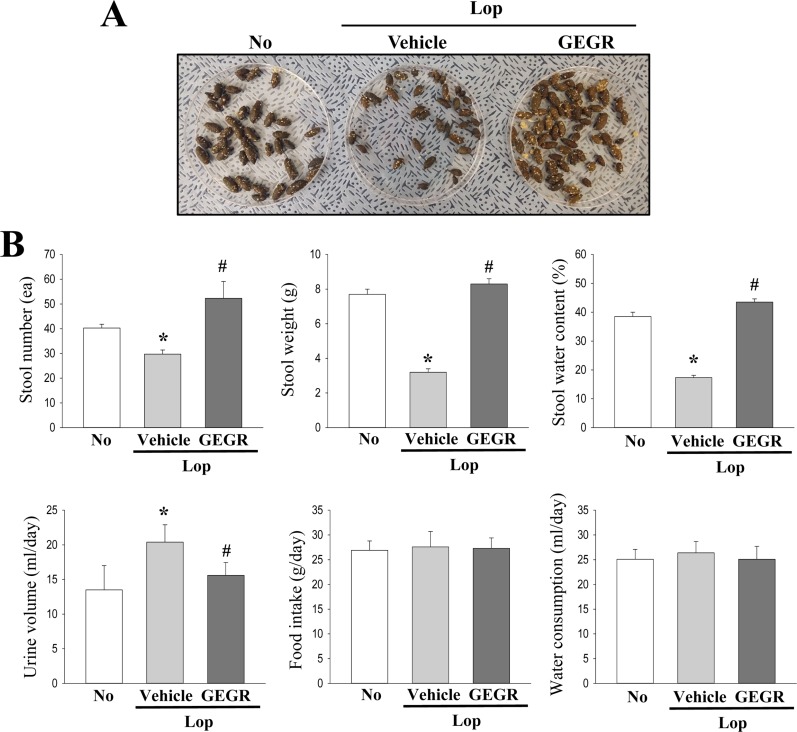
Figure 2
Recovery of histological structure in Lop+GEGR treated group. Transverse colon from the No, Lop+vehicle and Lop+GEGR treated groups were subjected to H&E staining to assess their histological structures. Stained sections were observed at 400× using a light microscope. Histopathological parameters were determined using the Leica Application Suite (Leica Microsystems, Heerbrugg, Switzerland). Data represents the mean±SD of three replicates. *P<0.05 compared to the No treated group. #P<0.05 compared to the Lop+vehicle treated group.
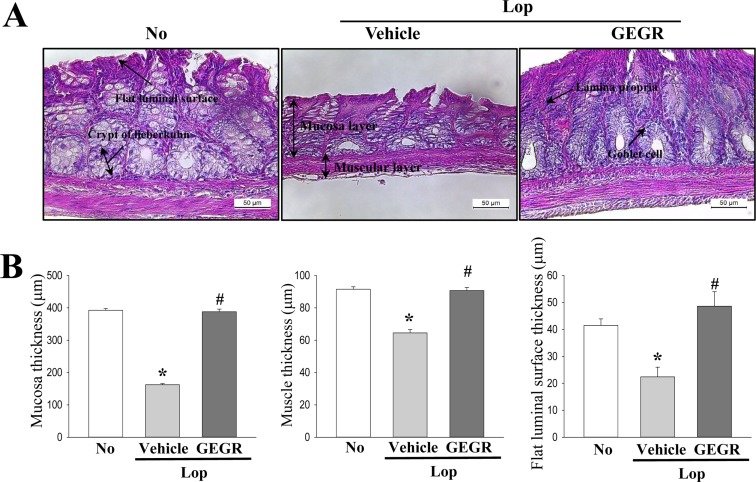
Figure 3
Alterations in the concentration of MTL and the downstream signaling pathway of its receptor in the transverse colon of Lop+GEGR treated group. (A) The level of MTL was quantified in the transverse colon homogenate by an enzyme-linked immunosorbent assay. The minimum detectable concentration of this kit is 31.25–2,000 pg/mL. (B) The level of IP3 was measured in the transverse colon homogenate by an enzyme-linked immunosorbent assay. The minimum detectable concentration of this kit is 5–1,000 pg/mL. (C) Phosphorylation level of PKC: The expression level of PKC and p-PKC were measured in the transverse colon of Lop+GEGR treated model using specific antibodies. Data represents the mean±SD of three replicates. *P<0.05 compared to the No treated group. #P<0.05 compared to the Lop+vehicle treated group.
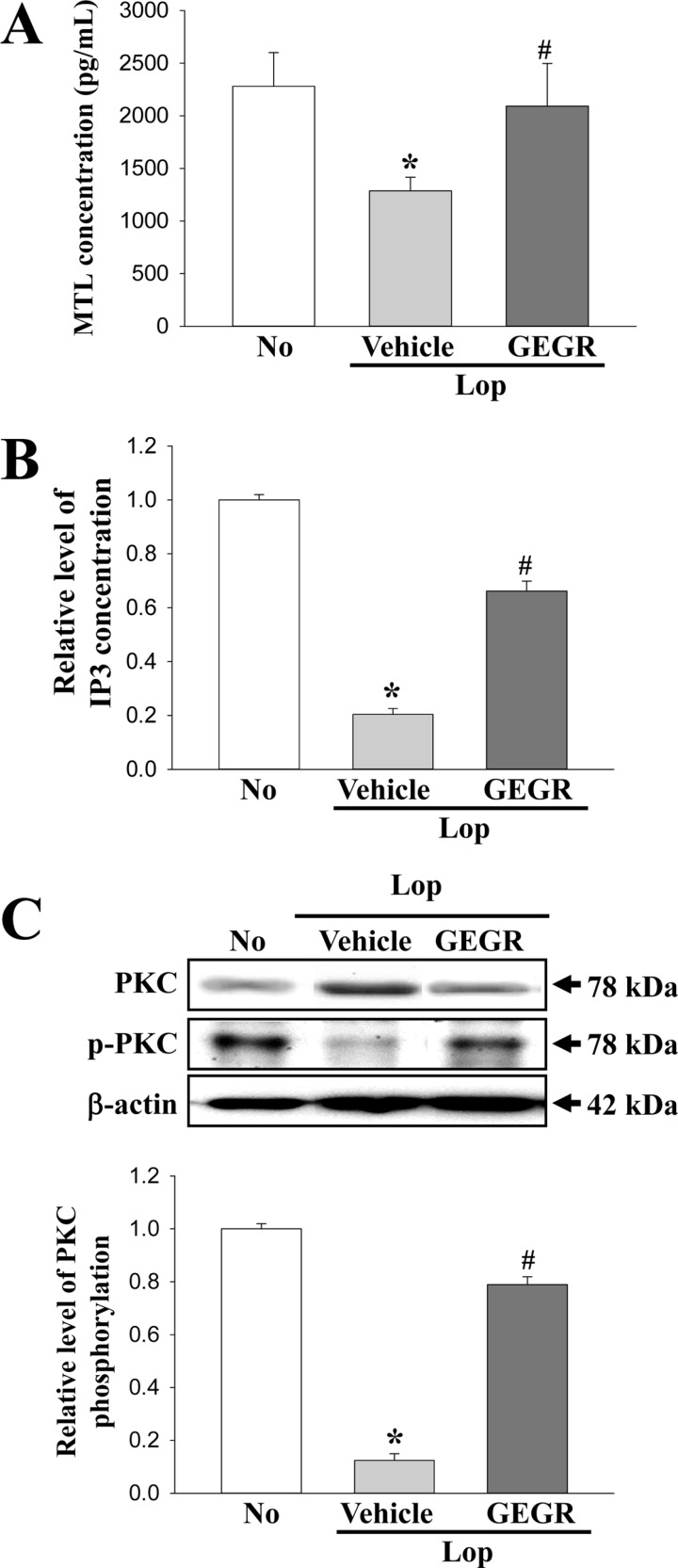
Figure 4
Alterations in the concentration of SS and downstream signaling pathway of its receptors in the transverse colon of Lop+GEGR treated group. (A) The SS concentration was measured in the transverse colon homogenate by an enzyme-linked immunosorbent assay. The minimum detectable concentration of this kit is 1.56–100 pg/mL. (B) The expression levels of Bax, p53, JNK and p-JNK in the downstream signaling pathway of SS receptor were measured in the transverse colon of Lop+GEGR treated model using specific antibodies. Data represents the mean±SD of three replicates. *P<0.05 compared to the No treated group. #P<0.05 compared to the Lop+vehicle treated group.
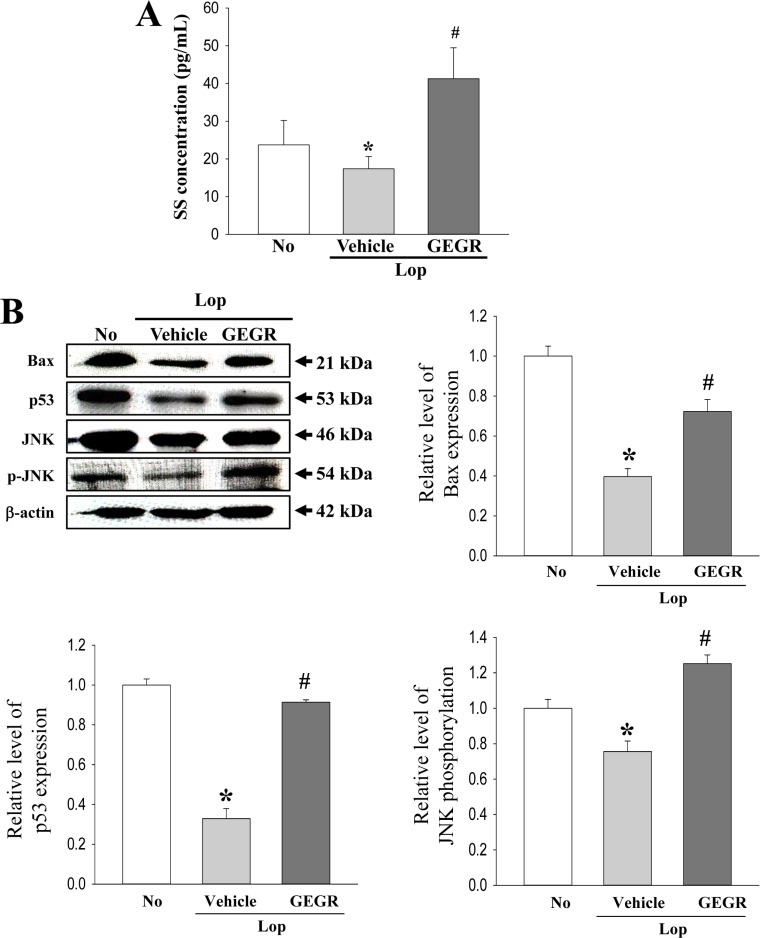
Figure 5
Alterations in the concentration of CCK and GAS in the transverse colon of Lop+GEGR treated group. (A) The CCK concentration was measured in the transverse colon homogenate by an enzyme-linked immunosorbent assay. The minimum detectable concentration of this kit is 0.1–1,000 pg/mL CCK. (B) The GAS concentration was measured in the transverse colon homogenate by an enzyme-linked immunosorbent assay. The minimum detectable concentration of this kit is 0.312–20 pg/mL. Data represents the mean±SD of three replicates. *P<0.05 compared to the No treated group. #P<0.05 compared to the Lop+vehicle treated group.
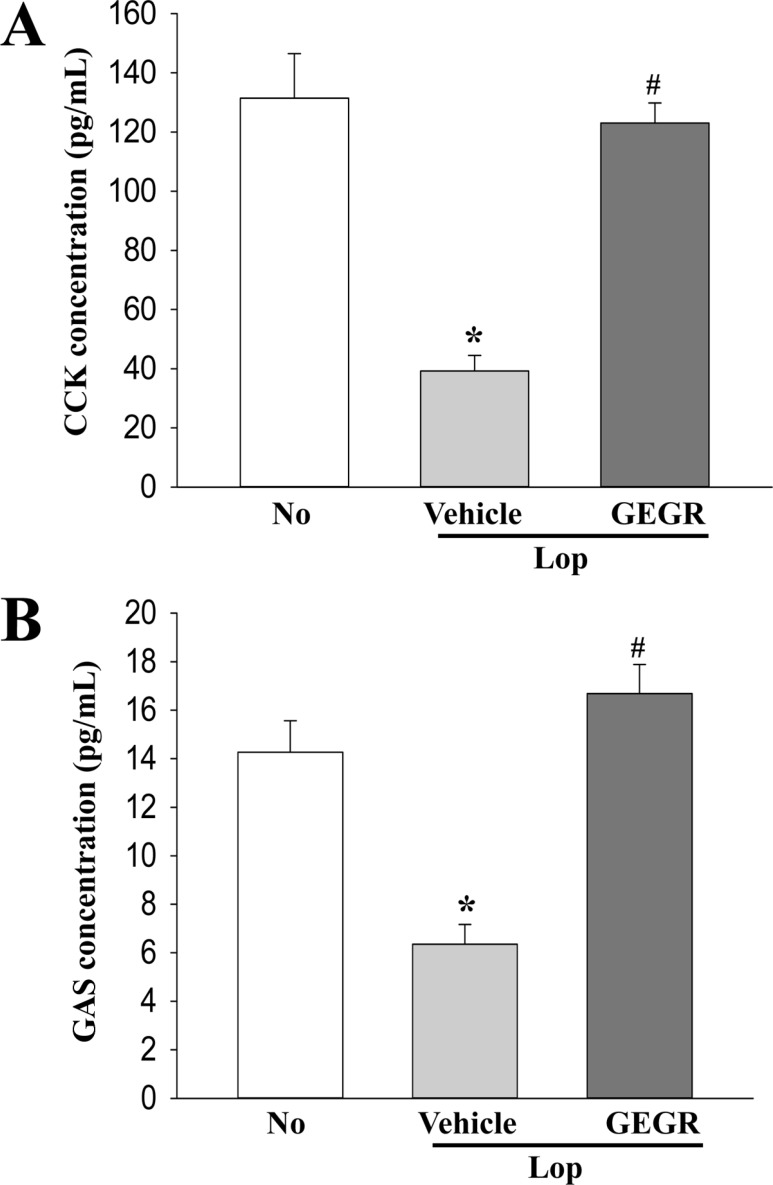




 PDF
PDF ePub
ePub Citation
Citation Print
Print


 XML Download
XML Download